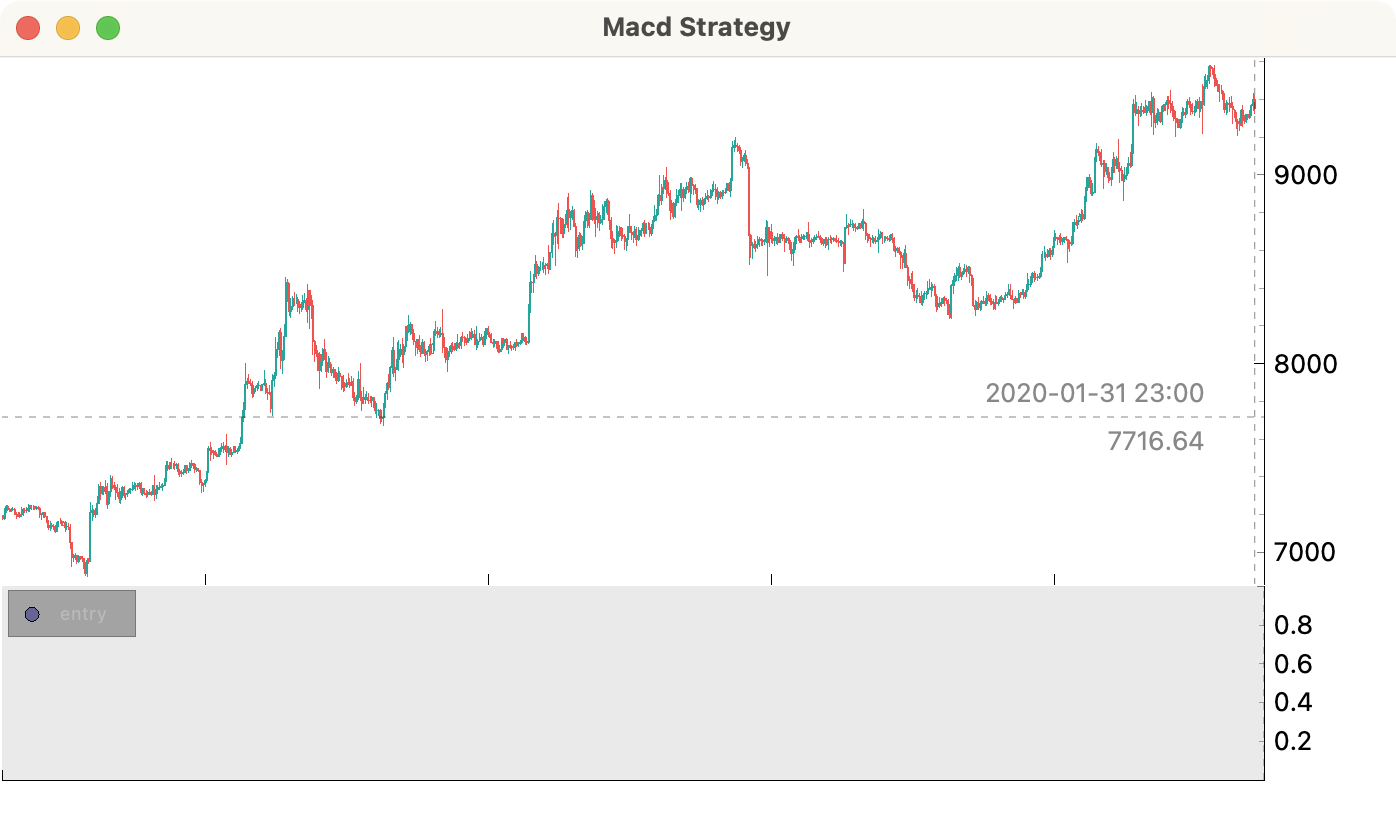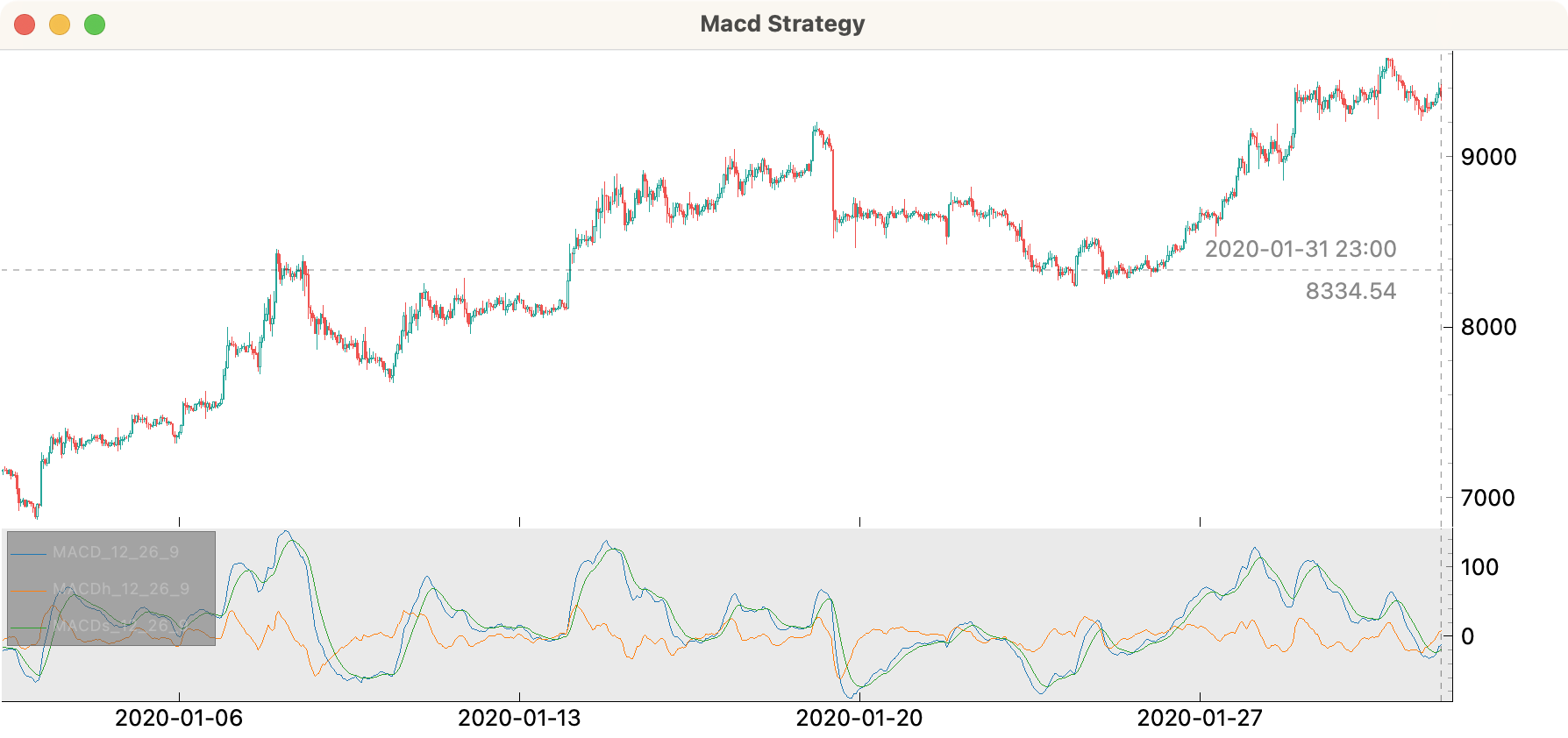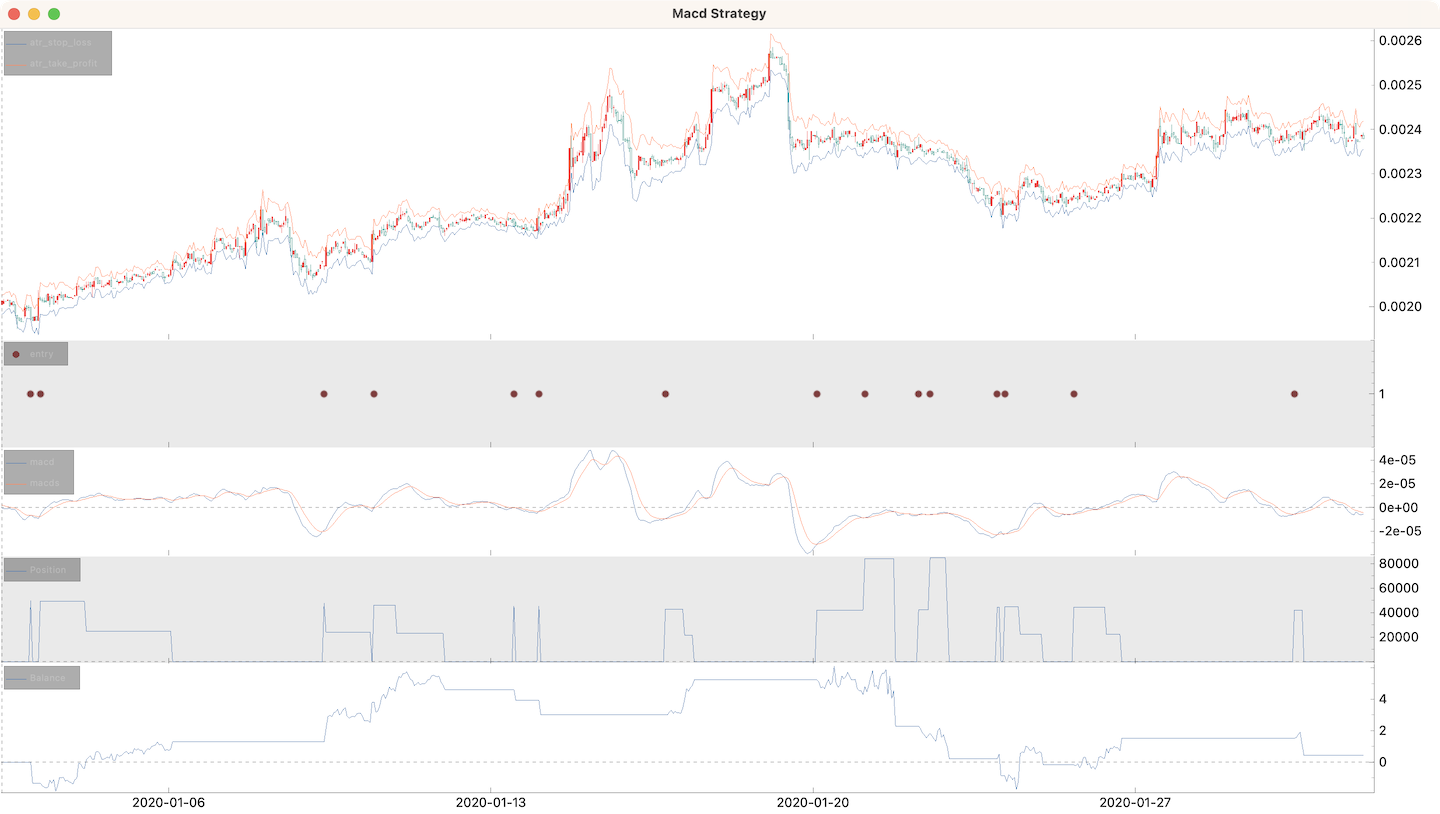Tutorial
This comprehensive tutorial demonstrates how to implement and test a Moving Average Convergence Divergence (MACD) trading strategy featuring ATR-based stop losses and a two-stage take profit system.
Strategy Overview:
- Entry Signal: MACD line crosses above signal line when both are below zero
- Stop Loss: Based on Average True Range (ATR) for dynamic risk management
- Take Profit: Two-stage system using ATR multiples for optimized exits
Original strategy source: Highly Profitable MACD Trading Strategy Proven 100 Trades (2 Stage Take Profit) on YouTube
Step 1: Creating the Strategy Template
Begin by creating a new strategy file:
cipher new macd
cat macd.py
This generates a basic strategy template:
from cipher import Cipher, Strategy
class MacdStrategy(Strategy):
pass
def main():
cipher = Cipher()
cipher.add_source("gateio_spot_ohlc", symbol="DOGE_USDT", interval="1h")
cipher.set_strategy(MacdStrategy())
cipher.run(start_ts="2020-01-01", stop_ts="2020-02-01")
print(cipher.sessions)
print(cipher.stats)
cipher.plot()
if __name__ == '__main__':
main()
Execute the initial backtest:
python macd.py

Step 2: Implementing Technical Indicators
Adding MACD and ATR Indicators
The strategy requires two key indicators:
- MACD: For trend identification and entry signals
- ATR: For dynamic stop loss and take profit levels
Interactive Development Approach
For experimentation, you can add a breakpoint in the compose method to test indicators interactively:
class MacdStrategy(Strategy):
def compose(self):
df = self.datas.df
breakpoint() # Interactive testing point
return df
Testing MACD Parameters
In the interactive session, test the MACD indicator:
talib.MACD(df.close, fastperiod=12, slowperiod=26, signalperiod=9)
# Returns: macd, macd signal, and macd histogram
To explore indicator parameters, use Python's help system:
import talib
help(talib.MACD)
Initial Indicator Implementation
class MacdStrategy(Strategy):
def compose(self):
df = self.datas.df
df["macd"], df["macds"], _ = talib.MACD(
df.close, fastperiod=12, slowperiod=26, signalperiod=9
)
return df
def main():
# ... existing code ...
cipher.plot(rows=[["ohlc"], ["macd", "macds"]])
Refined Indicator Setup
For cleaner code and better performance, implement indicators directly with custom column names:
class MacdStrategy(Strategy):
def compose(self):
df = self.datas.df
# Calculate MACD components
df["macd"], df["macds"], _ = talib.MACD(
df.close, fastperiod=12, slowperiod=26, signalperiod=9
)
# Calculate Average True Range for volatility-based stops
df["atr"] = talib.ATR(df["high"], df["low"], df["close"], timeperiod=14)
return df
def main():
cipher = Cipher()
cipher.add_source("gateio_spot_ohlc", symbol="DOGE_USDT", interval="1h")
cipher.set_strategy(MacdStrategy())
cipher.run(start_ts="2020-01-01", stop_ts="2020-02-01")
cipher.plot(rows=[["ohlc"], ["macd", "macds"]])

Step 3: Generating Entry Signals
Signal Logic
The entry signal triggers when:
- MACD line crosses above the signal line (bullish crossover)
- Both MACD and signal line are below zero (oversold conditions)
class MacdStrategy(Strategy):
def compose(self):
df = self.datas.df
# Technical indicators
df["macd"], df["macds"], _ = talib.MACD(
df.close, fastperiod=12, slowperiod=26, signalperiod=9
)
df["atr"] = talib.ATR(df["high"], df["low"], df["close"], timeperiod=14)
# Entry signal generation
difference = df["macds"] - df["macd"]
cross = np.sign(difference.shift(1)) != np.sign(difference)
df["entry"] = cross & (difference < 0) & (df["macds"] < 0)
return df
def main():
cipher = Cipher()
cipher.add_source("gateio_spot_ohlc", symbol="DOGE_USDT", interval="1h")
cipher.set_strategy(MacdStrategy())
cipher.run(start_ts="2020-01-01", stop_ts="2020-02-01")
cipher.plot(rows=[["ohlc"], ["signals"], ["macd", "macds"]])
Step 4: Complete Strategy Implementation
Full Strategy with Risk Management
import numpy as np
import talib
from cipher import Cipher, Session, Strategy, quote
class MacdStrategy(Strategy):
def compose(self):
df = self.datas.df
# Technical indicators
df["macd"], df["macds"], _ = talib.MACD(
df.close, fastperiod=12, slowperiod=26, signalperiod=9
)
df["atr"] = talib.ATR(df["high"], df["low"], df["close"], timeperiod=14)
# Entry signal
difference = df["macds"] - df["macd"]
cross = np.sign(difference.shift(1)) != np.sign(difference)
df["entry"] = cross & (difference < 0) & (df["macds"] < 0)
# Risk management levels
df["atr_stop_loss"] = df["close"] - (df["atr"] * 1.5)
df["atr_take_profit"] = df["close"] + (df["atr"] * 1.5)
return df
def on_entry(self, row: dict, session: Session):
"""Execute entry logic with risk management setup"""
# Position sizing: $100 worth of the asset
session.position = quote(100)
# Set initial risk management levels
session.stop_loss = row["atr_stop_loss"]
session.take_profit = row["atr_take_profit"]
# Store second-stage targets
session.meta["next_take_profit"] = (
row["close"] + (row["atr_take_profit"] - row["close"]) * 2
)
session.meta["next_stop_loss"] = row["close"] # Breakeven stop
def on_take_profit(self, row: dict, session: Session):
"""Implement two-stage take profit system"""
if session.meta["next_take_profit"]:
# First take profit: reduce position by 50%
session.position *= 0.5
# Set second stage targets
session.take_profit = session.meta["next_take_profit"]
session.stop_loss = session.meta["next_stop_loss"] # Move to breakeven
# Clear second stage flag
session.meta["next_take_profit"] = None
else:
# Second take profit: close remaining position
session.position = 0
def main():
cipher = Cipher()
cipher.add_source("gateio_spot_ohlc", symbol="DOGE_USDT", interval="1h")
cipher.set_strategy(MacdStrategy())
cipher.run(start_ts="2025-01-01", stop_ts="2025-02-01")
# Comprehensive plotting
cipher.plot(
rows=[
["ohlc", "atr_stop_loss", "atr_take_profit"], # Price action with levels
["signals"], # Entry signals
["macd", "macds"], # MACD indicator
["position"], # Position size over time
["balance"], # Portfolio balance
]
)
# Performance analysis
print(cipher.sessions)
print(cipher.stats)
if __name__ == "__main__":
main()

Session Period PnL
--------------------- -------- ---------
long 2020-01-03 00:00 1h -1.35068
long 2020-01-03 05:00 2d 21h 2.65973
long 2020-01-09 09:00 1d 1h 2.51076
long 2020-01-10 11:00 1d 13h 0.787893
long 2020-01-13 12:00 1h -0.678198
long 2020-01-14 01:00 1h -0.916931
long 2020-01-16 19:00 15h 2.21554
long 2020-01-20 02:00 1d 17h -1.82047
long 2020-01-21 03:00 16h -1.11205
long 2020-01-22 07:00 15h -1.10829
long 2020-01-22 13:00 10h -0.977476
long 2020-01-24 00:00 2h -1.09632
long 2020-01-24 04:00 20h 0.706303
long 2020-01-25 16:00 1d 1h 1.70895
long 2020-01-30 11:00 5h -1.09761
---------------- --------------------- ------
start 2020-01-02 09:00
stop 2020-01-31 23:00
period 29d 14h
trades 15
longs 15 100.0%
shorts 0
period median 15h
period max 2d 21h
success 6 40.0%
success median 1.9622442059571628645
success max 2.659732540861812779
success row 3
failure 9 60.0%
failure median 1.097612065354000837
failure max 1.820469798657718121
failure row 5
spf 0.6666666666666666
pnl 0.431161233126911900
commission 0E-18
balance min -1.8459700380155368
balance max 6.108997031624028
balance drawdown 7.844823888438853
romad 0.054961238041599234
---------------- --------------------- ------
Exercise
- Try different symbols, intervals, date ranges
- Experiment with different MACD parameters (fast/slow/signal periods)
- Test alternative volatility measures for stop loss calculation
- Implement shorting
- Add market regime detection for adaptive strategy behavior